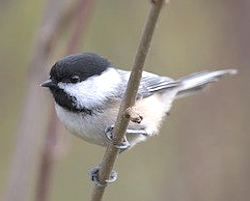
National Audubon Society
You commonly see them flitting about, the small, perky black and gray birds with the black hat and bib. A bird almost universally considered “cute” thanks to its oversized round head, tiny body, and curiosity about everything, including humans. Quick to find the bird feeders we love to set out, the black-capped chickadee is one of the first birds many of us become familiar with.
 |
The brains of chickadees grow in the late summer and early fall. At this time of year the birds cache food, usually seeds, throughout their home range. Come winter, they need to be able to find what they’ve stashed.
The growing part of the brain is the hippocampus, which plays an important role in spatial memory.
Dr. Fernando Nottebohm of Rockefeller University in New York studies the growth of neurons in the brains of birds. He focused on the remarkable ability of black-capped chickadees to recall the locations of hundreds of stored seeds.
His lab produced the first evidence that in the adult brain of birds neurons are replaced periodically, with the learning of new behaviors.
Dr. Nottebohm suggests that as demand for memory space peaks, chickadees discard cells that hold old memories and replace them with new cells that store fresh memories.
Studying the ability of a bird’s brain to generate new neurons might uncover ways to replace brain cells lost due to injury, stroke or degeneration, as happens in diseases such as Parkinson’s, Huntington’s and Alzheimers.
Perhaps we should reconsider how we use the term “bird brain!"